Housing & Built Environment
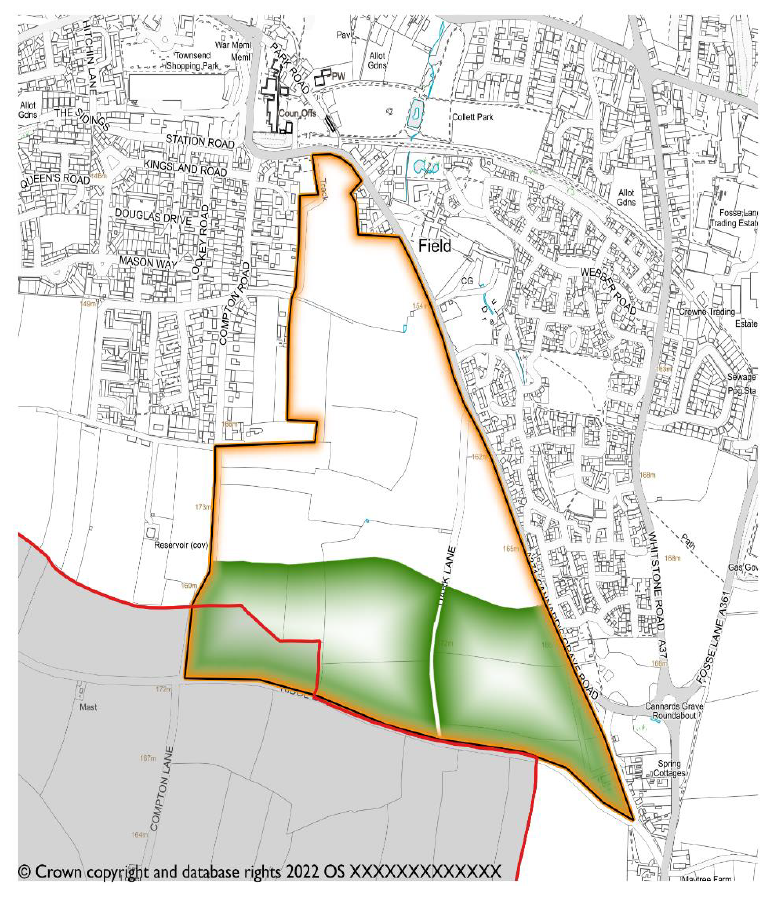
The 2011 census* shows that there are 48,719 households in Mendip District Council (MDC) of which 4,572 fall within the Shepton Mallet Neighbourhood Plan area. In Shepton Mallet, single person households form 10.6% of the total number of households which is slightly less than the figure of 13.8% for MDC. In addition, 29.1% of households in the neighbourhood plan area have dependent children marginally higher than the MDC figure of 27.3%. 6.7% of households are those with lone parents and dependent children, mirroring the MDC figure of 6.1%.
The MDC Local Plan part II pre-submission consultation, Housing and Employment Allocations (reference date March 2017) states the intention to deliver the assessed need for at least 9,635 new dwellings over the period to 2029, of which 30% is for affordable housing.
Twenty seven homes were completed to March 2019 and total identified supply is 786 dwellings. The supply figure includes allocated land at Cannards Grave Road which has been subject to a detailed master planning exercise and an outline application is under consideration
Taking into account the housing already built, the predicted housing at Cannards Grave Rd (600) and the consent granted for the former Shepton Mallet Prison (134 dwellings) the total number of housing to be developed in Shepton Mallet over the plan period is approximately 600 although this figure is not intended as a cap on housing delivery. For example, additional large windfall sites may come forward for development or the contribution to supply assumed to come from small windfall sites may be exceeded.
The Core Strategy aims to direct new development to the “five principal settlements” which includes Shepton Mallet. Most are sustainable locations, and the priority is to steer growth primarily to brownfield land, but it is recognized that some greenfield land is also required, including some sites to be released from the Green Belt because these are the most sustainable locations.
The Mendip Local Plan identifies that the sites allocated for development deliver a substantial uplift over Part 2 requirement and are therefore not allocating any additional sites in the Town.
Local Plan Part 1 identified a site SHEP092 in Core Policy 9 which stated that any release of this land would be made through the Neighbourhood Planning process. Subsequently this was removed stating: “As development will require a comprehensive approach –particularly infrastructure and access-this is better re-assessed in the context of the Future single Plan Review.”
The Shepton Mallet Neighbourhood Plan is allocating an additional site as a buffer of up to 10% on the Local Plan housing requirement of 734 dwellings. This provides a positive approach to growth along with flexibility for small-scale windfall development within the built-up area boundary, whist recognising this development must not compromise the ability of the local infrastructure to support this.
It should be noted that the proposed development at Cannards Grave is also required to deliver infrastructure which includes a primary school, which is expected to be sufficient to support the additional site allocation
* 2021 Census information was not available at the time of writing
Housing Allocations
In planning positively to help accommodate housing need within the environmental limitations of the Plan area (particularly from new households, younger families, older downsizing households as well as the specialist needs of older people), a site has been identified which is in addition to the strategic allocation in the Local Plan. The site has been confirmed as available by landowners and was assessed in the Mendip District Council HEELA, and independently assessed for the Neighbourhood Plan. The site has been carefully assessed against specific policies in the NPPF which indicate development should be restricted and other factors of local importance such as the coalescence of settlements, protecting the distinctive character of individual areas, and retaining landscape of high value and sensitivity.
The SMNP allocates a site for development, which exceeds that planned for through the adopted Local Plan, in an area with sensitive receptors. This includes a conservation area, nationally designated biodiversity, and geodiversity sites (within and in proximity to the neighbourhood area) and proximity to Somerset Levels and Moors Special Protection Area and Ramsar site. On this basis, the Mendip District Council SEA Screening Report (December 2021) considered that there is the potential for development as planned for through the SMNP to result in significant environmental effects. Therefore, an Strategic Environmental Assessment (SEA) process was undertaken to meet the specific requirements prescribed by the Environmental Assessment of Plans and Programmes Regulations 2004 (the SEA Regulations).
There are no internationally designated sites within the parish boundary of Shepton Mallet. However, the Somerset Levels and Moors SPA are approximately 13km west of the neighbourhood area, and Mells Valley SAC, covering 28.77ha, lies within 3 km of the NP boundary.
As part of the process of assessing this site being put forward for development, a Habitats Regulation Assessment was undertaken and identified that there is unlikely to be any adverse effect on the integrity of the Mells Valley SAC through recreational pressure, either alone or in combination with other plans and projects. The HRA also concluded the need for mitigation to ensure no adverse effect on water quality and this has been included in the Policy. This mitigation proposed by applicants is required to be in line with the emerging Phosphate Management Strategy.
The creation of greenspaces with easy accessibility to all residents and the wider community also forms a key component of this policy. Development is also required to ensure that residential amenities in respect of privacy, daylight and sunlight are safeguarded, through careful site layout, property orientation, landscaping and detailed design. Appendix Shepton Mallet Design Guide.
The potential density and type of development proposed in this plan responds to the vision and objectives, which identifies the need for additional affordable housing in particular. An approximate housing capacity is included for the site. This is based on the approximate net additional dwellings to be achieved on this site.
The NPPF makes it clear that neighbourhood planning provides a powerful set of tools for local people to ensure that they get the right types of development for their community. The Neighbourhood Plan contains policies which ensure development is designed to a high quality and responds to the heritage and distinctive character of the individual areas of Shepton Mallet in which it is located, as well as site specific constraints. These requirements reflect the input of local residents and infrastructure providers.
POLICY ONE. HOUSING REQUIREMENT
OBJECTIVE ONE:
To allocate a site for future development in Shepton Mallet to meet the identified needs of the community including the provision of affordable homes
i. New development in Shepton Mallet shall be focused within the settlement boundary with the exception of the site allocated (SHEP092) in Policy 2 as identified on the Proposals map.
ii. The Neighbourhood Plan provides for a minimum of 150 dwellings to be built in the period 2016 to 2036 and the following site is allocated for development:
• SHEP092 Land West of Cannards Grave
iii. Development proposals outside the settlement boundary and the site allocation will not be permitted unless:
• they represent appropriate uses in the countryside, such as agriculture, forestry, horticulture, fishing and equestrian activities, and energy generation;
• they relate to the retention of existing and appropriate provision of new commercial businesses and meet the requirements of other policies in this Plan;
• they relate to necessary utilities infrastructure and where no reasonable alternative location is available.
Iv. Development on the site allocation in Policy 2 will be expected to address the following key matters: • the provision of new housing which addresses evidence-based needs;
• the provision of key infrastructure including education, health, transport and movement, community facilities, utilities and public realm improvements, through direct provision and/or developer contributions (including Community Infrastructure Levy and/or Section 106) as directed in the relevant policies;
• design high quality buildings, guided by the Shepton Mallet Neighbourhood Plan Design Guide Appendix, and deliver them in layouts with high quality natural landscaping in order to retain the rural character and physical structure of Shepton Mallet, conserving, and where possible, enhancing the historic environment.
iv. Additional development which would result in Shepton Mallet growing by significantly more than the minimum number of dwellings required by the Mendip Local Plan plus the allocation in Policy 2, over this period, will not be supported.
v. Given the sensitivity of the Somerset Levels and Moors Ramsar to elevated phosphorus loading and resulting eutrophication, all residential developments contributing to the total wastewater burden in the Neighbourhood Plan area must demonstrate phosphorus neutrality. Developments with an identified phosphorus surplus, will be required to provide appropriate mitigation measures (e.g., wetlands, reedbeds) in agreement with the Local Planning Authority and Natural England. The requirement for mitigation will be commensurate with the scale of development and might be achieved strategically, particularly in the case of smaller developments.’
Reasoned Justification for Policy One

1 Mendip District Council's Local Plan states that Shepton Mallet should provide at least 1,300 dwellings between 2014 and 2029. With the housing requirement being a ‘floor’ not a ‘ceiling’ it is important to balance the competing issues that will shape the quantum of housing that should be delivered over the plan period:
o The Neighbourhood Plan must plan positively for growth and must make its contribution towards addressing Shepton Mallet’s, and the District’s, ‘full and objectively assessed needs for market and affordable housing’ as required by the NPPF.
o There are already a large number of dwellings in the planning pipeline, either within or immediately adjacent to the neighbourhood area that will address a significant proportion of housing needs, particularly for affordable housing.
o The overall quantum of development must not compromise the sustainability of Shepton Mallet and its infrastructure, particularly its education and health services, and no additional development should take place until the appropriate infrastructure is in place and functioning .
2 By providing a site allocation in the Neighbourhood Plan, residents, developers, and service providers, will have a greater degree of certainty about what sites are likely to come forward in the future, in what order and for what purpose. In short, by identifying specific sites within Shepton Mallet, decisions on planning applications can be a given a clear steer immediately, and the community is more likely to see the development it wants take place.
3 Unlike many other areas in the District, Shepton Mallet has a younger population, many of whom wish to get onto the property ladder in Shepton Mallet, so the Neighbourhood Plan seeks to address their needs where these needs are not already met.
4 The needs of these first-time buyers – young people and families – are currently finding it very difficult to access properties on the open market.
5 The new strategic developments proposed within the Mendip Local Plan will go some way towards addressing this need, however recent HNA information* indicates there is insufficient planned growth within the Mendip Local Plan.
6 As a “principal town” within the Mendip District Council area, Shepton Mallet will be required to provide for a significant proportion of this unmet need. Therefore, it is correct to consider the most appropriate site for this future development.
7 Development has the opportunity to provide for the community’s wider infrastructure needs, particularly in respect of education, green open spaces and biodiversity.
8 Without a clear strategy for directing growth, Shepton Mallet could be subject to a quantum of additional development that would fundamentally change the nature of a parish that is centred on a single small town.
9 In establishing the level of new development that should be planned for in Shepton Mallet it is necessary to balance needs with the supply of sites.
10 The Neighbourhood Plan must deliver the housing requirement set by the Mendip Local Plan of a minimum of 1300 dwellings and this will be achieved predominantly through the allocation of sites in the Local Plan, at Cannards Grave and Shepton Mallet Prison site plus those already delivered. This will serve the needs of Shepton Mallet; however, it will only go some way towards addressing the requirements of local people with housing needs. This is a significant consideration in determining whether additional housing should be brought forward in Shepton Mallet.
11 Shepton Mallet also has more jobs than the available workforce can supply resulting in a net flow of people into the town for employment, with no available opportunity to live in the town due to the lack of housing supply.
12 With the creation of additional employment to be delivered through the development at the Mid Somerset Showground site, job growth over the whole plan period is projected to be in the order of 1,300 – 1,500.
13 In addition, Shepton Mallet currently has the second largest concentration of employment land and premises in the district, leading to further increase in jobs available.
14 This growth in employment alone will require additional homes to provide for a workforce who currently cannot live in the place of their employment due to a lack of housing available.
15 This increase in need will bring with it the additional need for affordable housing. Although the strategic allocations at both the Prison and Cannards Grave will deliver a proportion of the identified need, there will still be a shortfall.
16 The allocation of the site in Policy 2 provides for a buffer of +25% which is considered to be sufficient given the scale of development already allocated to Shepton Mallet through the Mendip Local Plan.
Settlement Boundary and Site Allocation

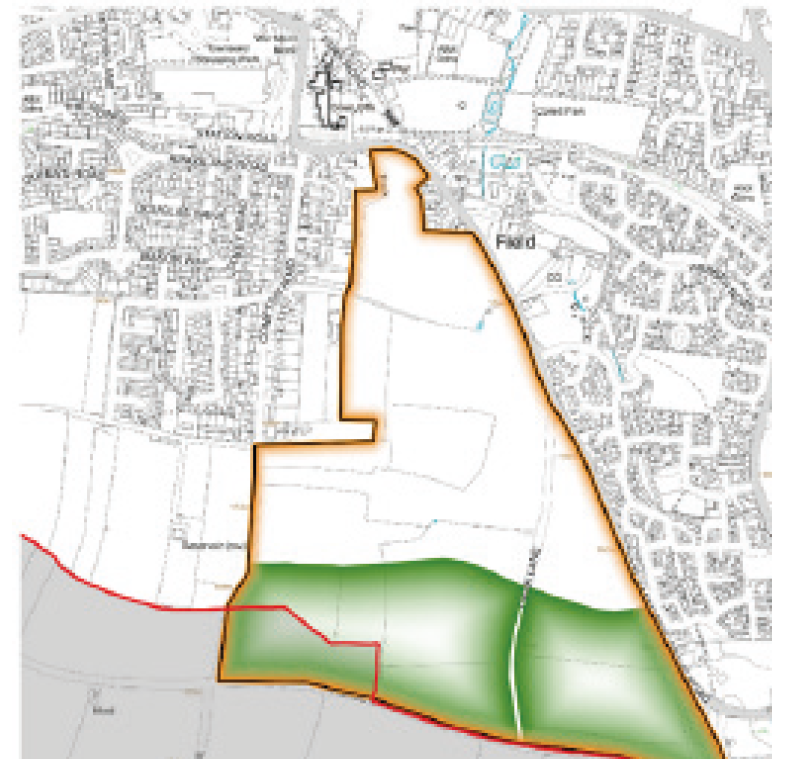
POLICY TWO: SITE ALLOCATION
OBJECTIVE ONE
To allocate a site for future development in Shepton Mallet to meet the identified needs of the community, including the provision of affordable homes
OBJECTIVE THREE
To ensure new houses are of high quality design, in keeping with the established character of the area, and built to BREAM standards
- This portion of the site, SHEP092, (19.4 ha) within the Plan area, as indicated on Proposals Map is allocated for residential development. Proposals will be supported subject to the following criteria:
- It provides between 140 and 150 dwellings
- It provides a mix of dwellings in accordance with Policy Four of this Plan
- It delivers the full quota of 30% affordable housing on site, unless there is compelling and credible evidence to demonstrate why this would not be viable
- Green open space is provided to serve the new dwellings
- Vehicular access is provided from the northeast corner as marked on the Proposals Map (subject to discussions with highways authority)
- Pedestrian and cycle access is provided to key facilities
- Appropriate drainage solutions and management strategies are provided to serve the needs of the development
- In order to protect the amenity of neighbouring properties, landscape buffers are provided on the north and east boundaries of the site
- Any development must ensure appropriate landscaping is provided to minimise the landscape and visual effects of development and should be included in design proposals
- Design of this development should use the Design Codes Appendix of this Plan, to guide proposals
- To spread the provision of new dwellings over the plan period, this site should not come forward before all the appropriate infrastructure is in place to support it
- Given the sensitivity of the Somerset Levels and Moors Ramsar, to elevated phosphorus loading and resulting eutrophication, the masterplan for development on this site is required to demonstrate phosphorus neutrality in accordance with Policy One of this Plan.
- Should this developments demonstrate an identified phosphorus surplus, it will be required to provide appropriate mitigation measures (e.g., wetlands, reedbeds) in agreement with the Local Planning Authority and Natural England and in accordance with Policy One of this Plan.
Reasoned Justification for Policy Two
17 The Mendip Spatial Strategy identifies the five principal settlements which includes Shepton Mallet, as suitable for development.
18 Under the Mendip Local Plan, Shepton Mallet has been allocated its quota of development, with what has been built and what is in the planning pipeline. This will serve to provide new homes for the community as well as placing additional demands on the infrastructure of the Neighbourhood Plan area. As shown above, this amounts to around 600 houses at Cannards Grave and 134 dwellings from the redevelopment of Shepton Mallet Prison making a total of 734 new dwellings within the parish boundary
19 A scheme for around 600 new dwellings, a primary school, a local centre, a new permanent home for the annual Mid Somerset Show and substantial parkland open space on a site close to the town centre is allocated in the Mendip Local Plan. Outline Planning Permission was expected by the end of 2021 due to delays in the planning system caused by phosphate run off to the Somerset Levels. This outline permission has still not been granted, a Phase 1 detailed application will be required, a site start is therefore a little way off.
20 The Shepton Mallet Neighbourhood Plan Steering Group gathered evidence from a variety of sources to assess the expressed need for smaller homes, both for older people wishing to downsize and for younger families requiring homes they can afford.
21 In order of need, the housing needs of existing residents are:
• One- or two-bedroom bungalows.
• Three- or four-bedroom houses.
• Three- or four-bedroom bungalows.
• One- or two-bedroom houses.
• Larger family houses.
• Flats.
• Assisted living/sheltered accommodation.
22 In summary, over the next 15 years Shepton Mallet will need:
• A range of future-proofed bungalows, particularly with regard to accessibility issues, and houses suitable for those wishing to downsize, thereby releasing larger family homes onto the market.
• Small, comparatively cheaper housing suitable for rent or purchase by young/first-time buyers.
• Starter homes (which represent one type of affordable housing).
• Accessibility should be at the forefront of design when considering development
23 Master-planning of the strategic site at Cannard’s Grave Rd, has not ruled out the potential for further western expansion and provision has been made in development and highway layout terms to achieve connectivity to the Site SHEP092, which falls partially in the Plan boundary, the southern part of the site falling in Pilton Parish, and is allocated through this Neighbourhood Plan. It was part of the Future Growth Area (FGA) however, in the Main Modifications of Local Plan II this site was removed.
24 The approach taken in the Shepton Mallet Neighbourhood Plan is to identify a location which achieves the objectives of the Plan whilst also providing a spatial strategy for contributing towards the delivery of the Mendip Local Plan housing requirement shortfall. Therefore, the site, SHEP092, proposed in Policy 2 is allocated.
25 The proposed location has the main vehicular access onto Compton Road. Middleton Lane is the northern boundary and Compton Road forms the eastern boundary, where both of these are narrow single-track lanes.
26 Vehicular access proposed onto Compton Rd is expected to cause difficulties. To the south of Middleton Lane, Compton Lane is a narrow largely single-track road, as shown on Fig and any development traffic would need to avoid this section of Compton Road. North of Middleton Lane, Compton Road is fairly wide and should be able to accommodate some traffic but is fronted by residential development on both sides of the road as shown on Fig. Adding significant generated traffic routing along this road will impact on many existing dwellings.
27 It is therefore recommended that an alternative highway access is identified, such as via the Cannards Grave development and any impacts on Compton Road are carefully investigated with a view to provide mitigations as appropriate.
28 The increase in population will be partly in response to the increase in employment opportunities in Shepton Mallet. This will increase the need for affordable housing for sale.
29 Affordability of housing is the major issue in Mendip as it is across much of southern England. Between 2001 and 2006 Mendip District experienced some of the largest house price rises of any of the local authorities in the West of England area. The average price of a semi-detached house rose by 63%. By the end of this period the proportion of young households able to buy or rent in the market fell to 42%.
30 Average property prices have followed a clear upward trajectory over the past 10 years, leaving the median value 56% higher in 2022 than 2013. The current median price is £245,000, and the lower quartile (entry-level) price stands at £180,000. There is a clear gap between the higher costs of detached housing and more affordable property types. Flats are the lowest cost option, and have also appreciated in price much more slowly than have detached homes.
31 Comparing the costs of a range of different tenure options in Shepton Mallet to local household incomes suggests that market housing for purchase remains out of reach to all but the highest earners. The average household earns £41,000, but the average home requires an annual income of £63,000 to qualify for a 10% deposit mortgage (in addition to the savings for the deposit). Private renting is more affordable, especially as most rented homes have 1-2 bedrooms, but even the smallest options are beyond the financial capability of lower earning households.
32 Affordable housing products designed to widen access to home ownership, such as First Homes and shared ownership, would significantly lower the barrier to ownership, providing access to those earning 25-40% below the average income (depending on the products available). More traditional affordable housing tenures that are rented from social landlords and housing associations are vital as the only option for people on lower incomes.
33 Affordable housing is typically provided and made financially viable by its inclusion as a proportion of larger market developments, as guided by Local Plan policy.
34 AECOM (Shepton Mallet HNA 2023) has estimated that an average of 6.3 Shepton Mallet households will fall into need of affordable rented housing per year after deducting those who could be accommodated if the current rate of turnover through vacancies in the existing stock persists. This equates to around 127 additional affordable rented homes during the Neighbourhood Plan period.
35 In addition, AECOM has estimated that there could be potential demand from up to 38 households per year for affordable home ownership products. This estimate counts anyone who can afford to rent but not to buy. However, it is not possible to estimate whether everyone in this large group can afford the cost of a mortgage or deposit to purchase a property, nor whether they actually want to. As such, the total of 764 such households over the Neighbourhood Plan period should be viewed as a loose expression of the potential size of the market segment that such products are aimed at, and who might take advantage of them, but is not ‘need’ in the formal sense nor a target that must be met.
36 It is therefore justifiable to request an increase in the delivery of affordable housing in order to achieve a more balanced and equitable distribution of home ownership.
37 Development on this site will also be required to adhere to other policies within this plan which are designed to achieve a housing mix which delivers more affordable homes for sale.
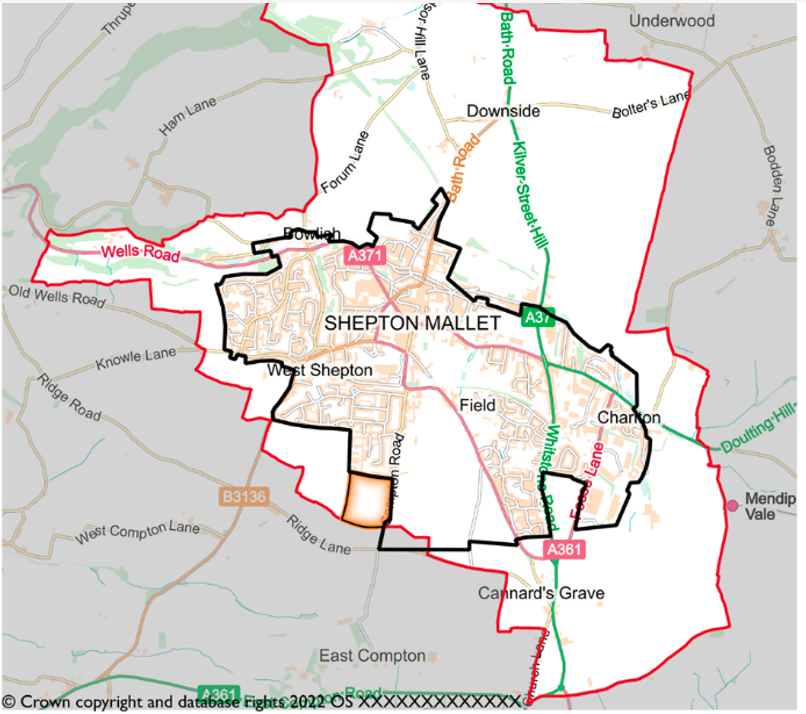
Site Allocation Map
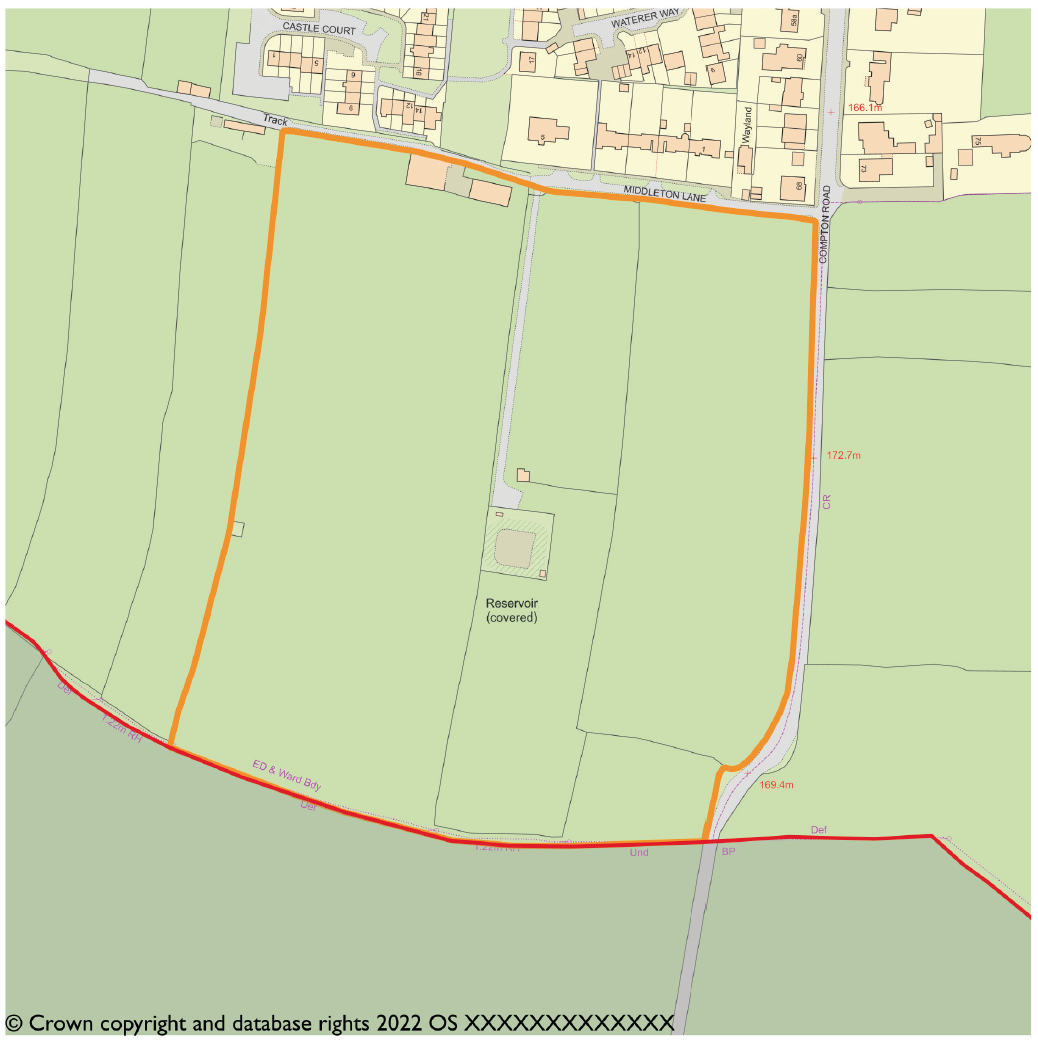
Affordability thresholds in Shepton Mallet (income required £ )
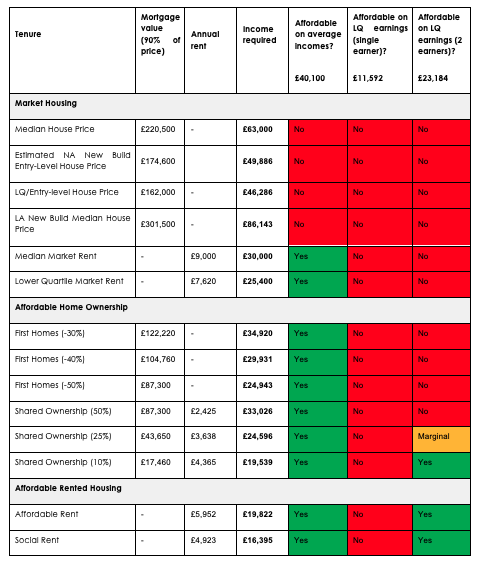
POLICY THREE: HISTORIC ENVIRONMENT / LAYOUT & DESIGN
OBJECTIVE 2
To ensure new development is sustainable and helps to protect the distinctiveness, character, and historic assets of Shepton Mallet, which also does not harm the conservation area
OBJECTIVE 10
Ensure any infill development in Cowl Street and Hillmead area is of high quality and sympathetic to its surroundings
OBJECTIVE 20
Preserve the historic core of the town
OBJECTIVE 21
To have a thriving community which maintains its heritage assets and green areas as a haven for wildlife
- All types of development proposals are expected to contribute towards the local distinctiveness of the Shepton Mallet Neighbourhood Plan Area, its overall rural setting and its heritage. They should demonstrate high quality, sustainable and inclusive design and architecture that respects the Conservation Area, (as shown on the Proposals Map) or the surrounding area if located outside or away from the Conservation Area. Proposals should address the following criteria:
- The importance of responding creatively to, and enhancing, the setting of the surrounding area, having regard to the character of adjacent buildings and spaces, including scale, orientation, height and massing.
- High quality materials should be used that contribute positively to the surrounding area if outside it and respect the local setting.
- Retention of traditional heritage features eg metal railings.
- Colour schemes of buildings should be in keeping with those in the surrounding area.
- Ensure that designated heritage assets and their settings are preserved and where possible, enhanced.
- Archaeological investigations are undertaken prior to development if there is a reasonable likelihood of archaeological remains being found on or adjacent to the site
- Appendix “Shepton Mallet Design Guide,” identifies the buildings and structures which are locally important heritage assets and must be preserved
- These heritage assets and character areas must be considered in determining an application in order to avoid or minimise conflict between the conservation of these areas and assets and any aspect of the proposal
- All new development proposals – including those that relate to the site allocation in Policy Two SHEP092 – are required to demonstrate good place-making principles in their design and layout.
- Good design should provide sufficient external amenity space for refuse and recycling storage, and car and bicycle parking to ensure a high quality and well managed streetscape. In particular, dedicated off-street parking provision for residential properties should preferably be provided without the loss of existing front gardens.
- Development that seeks to meet the highest possible standards of construction Code for Sustainable Homes and BREEAM (Building Research Establishment Environmental Assessment Method) standards or equivalent will be strongly supported.
- Layouts must retain important trees and hedgerows. The planting of new trees and shrubs of similar species to those already evident in the immediate surroundings shall be encouraged.
- Applications will be required to demonstrate how accessibility issues have been incorporated into design.
Reasoned Justification for Policy Three
38 National policy is clear that design must be of a high quality and inclusive. In particular, the NPPF notes that design policies should respond to local character and history and reflect the identity of local surroundings and materials, while not preventing or discouraging appropriate innovation. The community of Shepton Mallet recognises the need to achieve balance; on one hand, tradition in design is very important to people and on the other hand, the need to innovate in order to address wider issues such as energy efficiency and resilience is also seen as vital to the community’s future.
39 Whilst encouraging innovation in design therefore, the Neighbourhood Plan reflects the importance of traditional materials and styles to Shepton Mallet. This has been informed by the evidence base used to develop the Shepton Mallet Neighbourhood Plan Design Guide which identifies that the principles and issues contained in it are important to the people of Shepton Mallet.
40 Shepton Mallet is identified by the quality of its architecture and townscape which provides its overall character and form.
41 Mendip limestone is the prevailing material, mainly locally quarried Forest Marble and Doulting Stone. Earlier houses in Shepton Mallet are mostly of random or coursed Forest Marble with plenty of mortar showing due to the unevenness of the stone.
42 The Parish of Shepton Mallet contains a large number of buildings and structures which are of special historic and / or architectural interest to warrant designation as listed buildings.
43 They have a distinct and valued local character and / or appearance that are worthy of retention as part of development proposals.
44 The intention of Policy 3 is to restate the desire of the local community to see the continuation of the protection offered to these buildings and character areas.
45 All of the buildings and structures are identified as a result of:
• Being very good examples of traditional or established style, or unusual type
• Being buildings or structures, which contribute towards the local townscape or have important historical associations
• Remain largely intact and have not been adversely affected by later extensions or alterations
46 Appendix, Shepton Mallet Neighbourhood Plan Design Guide, identifies these special character buildings or structures and their importance within the identified character areas.
47 It is clear from the consultation and engagement process that the community wish to see any new developments in the plan area, integrated within the existing rural setting in ways that enhance the area rather than diminish what is distinctive about the settlements and their setting, or undermine their established character. This applies whatever the specific form or purpose of any building development. This policy will apply to any and all development proposals that come forward.
48 Shepton Mallet has developed over time from its historical beginnings as a mill town. This development has been both within and outside of the existing conservation area. Shepton Mallet built up area is broken into fivecharacter areas identified and detailed fully in the conservation area documentation provided by Mendip District Council:
• Character Area One: Town Centre including Commercial Road and the Anglo Trading Estate
• Character Area Two: Sheppey Valley including Hill Lane, Pike Lane, Cowl Street and HM Prison
• Character Area Three: Waterloo Road, Princes Road and open space south of the former railway
• Character Area Four: Darshill and Bowlish
• Character Area Five: Charlton and the Charlton Viaduct
49 In seeking to maintain the character of Shepton Mallet as a small market town, it is important to ensure that should strategic development be directed outside the built-up-area boundary, it reflects its historic character and does not result in a dense form of development or create a “sprawl effect” with the town growing inadvertently to the limits of the Plan boundary.
50 In Shepton Mallet, houses are mainly 1 – 2.5 storeys high with a small minority of 2.5 – 3 storey town houses and apartments. There are areas in Shepton Mallet where houses do have three stories, however, these are set in grounds proportionate to the dwelling and therefore do not dominate the street scene.
51 A comfortable variation in the size and scale of buildings, from single storey to three storey townhouses, can enhance local character by providing variety and difference as opposed to homogeneity. However, new development should take care to fit with the existing local scene and not dominate it.
52 With a number of site allocations bringing a significant level of growth to Shepton Mallet over the period to 2029, one of the most important messages which was raised by the community was that Shepton Mallet should not lose its identity as a small market town and one with many distinctive characteristics. This includes its rural location on the edge of the Mendip Hills on either bank of the River Sheppey.
53 In addition, it is necessary for growth to be well planned, well designed and well laid out. Given the gently undulating topography of Shepton Mallet, development needs to fit into the landscape without intruding on the views of the surrounding Mendip Hills. To achieve good design, it is important that proposals recognise the character of Shepton Mallet in terms of its building design and layout and the relationship of the built edge of the town with the surrounding countryside. Trees, hedges and vegetation generally can soften the impact to development, improve the street scene and keep the rural feel of the area.
54 As well as being of aesthetic and practical benefit, good design attracts buyers, encouraging people into the town. It also enhances well-being and helps prevent discomfort and disharmony.
55 The space between homes is also a concern for new developments. When a developer builds too many dwellings in a small area, the over-development leaves a legacy of issues that must be avoided in future developments. These include:
i) Insufficient parking for cars
ii) Insufficient garden space
iii) A crammed feel to the street scene, making it feel urban rather than a development that is part of a small market town
56 With a need for a “healthy nation” new developments should ensure they provide garden space of a useable size and shape to enable the production of produce and to avoid the feeling of over-development with properties overlooking one another.
57 In order to maintain the varied mix of finishes and materials that provide the distinctiveness and unique feel of Shepton Mallet, it is important that the quality of design and materials used in new developments, extensions, and renovations, must not have an adverse impact on neighbouring properties or the character of surrounding areas within the neighbourhood area.
58 The community of Shepton Mallet is concerned that the historic area surrounding Cowl Street and Hillmead should be maintained. Cowl Street and its environs form part of original mediaeval settlement and population along the banks of the river Sheppey. Cowl Street itself comprises many listed buildings, a former chapel, an historic bridge allowing vehicle entry to the town’s cemetery and high natural limestone walls on one side forming a unique streetscape. Gold Hill, one of the gateway views in Policy 16, is accessed from Cowl Street and also provides residents with walking and cycling access to the recreation area of Barren Down and one of the community woodland spaces in the town.
59 The Hillmead housing estate sits on a former gas works site and was therefore a brownfield development when it was started in the 1970’s and 80s. However, the wider Hillmead area comprises much of the historic silk mill and weaving history of the town. For example, Draycott road which borders the Hillmead Estate, comprises areas of former mediaeval settlement, historic blue plaque buildings and former mills as well as a very fine example of a Tudor dwelling. It was also the site of the town’s hanging tree, historic convent and, masonic hall.
60 However, during the 1990’s and 2000’s some poor quality infill applications were approved for dwellings to be slotted into small spaces with little or no outside space and curtilage cut directly into the rocky hillside. This has already damaged the street scene and this Policy seeks to prevent further damage occurring in this historic area of the town.
61 The Shepton Mallet Design Guide provides more comprehensive discussion of the local character and materials which form the historic environment of the neighbourhood area and should be referred to for detailed guidance.
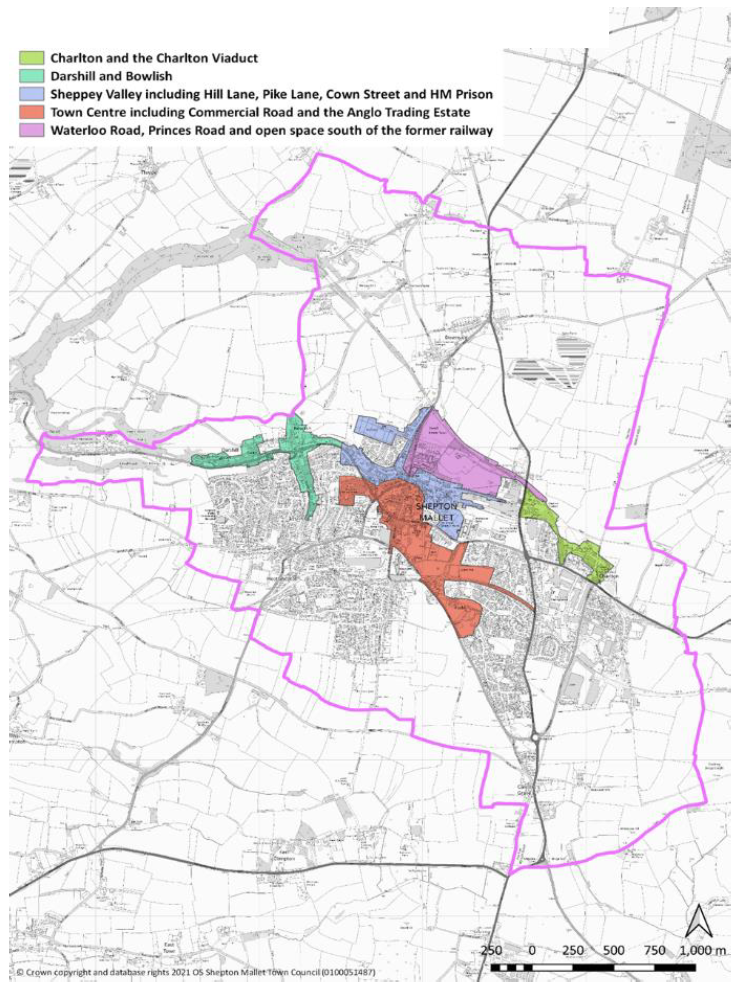 Fig: Character Areas in Shepton Mallet Fig: Character Areas in Shepton Mallet |
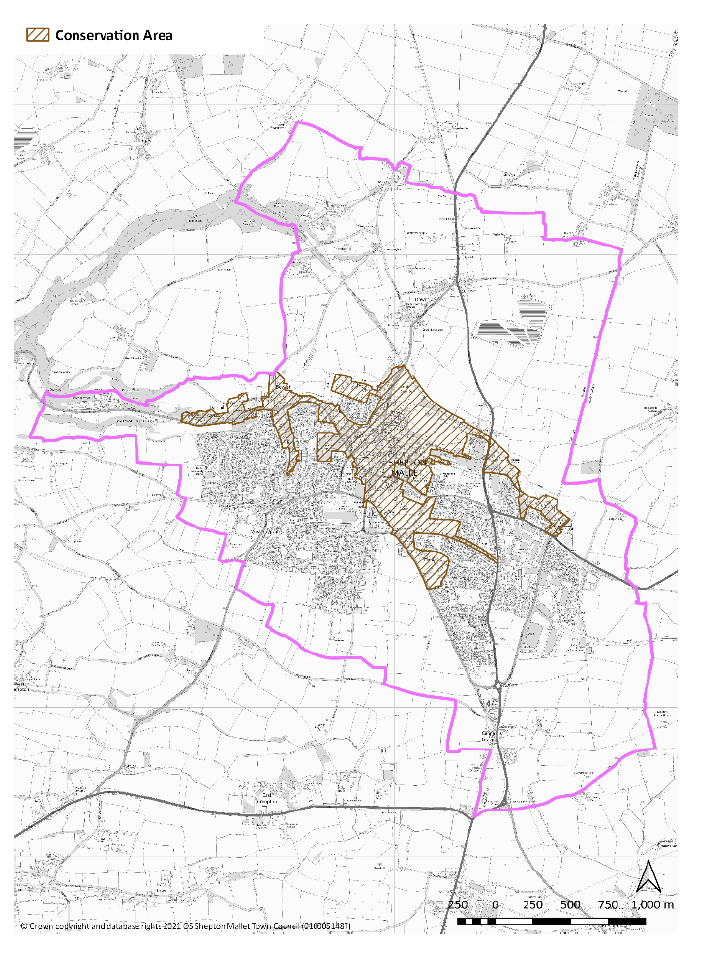 Fig: Conservation Areas in Shepton Mallet Fig: Conservation Areas in Shepton Mallet |
POLICY FOUR: DENSITY AND MIX
OBJECTIVE THREE
To ensure new houses are of high-quality design, in keeping with the established character of the area, and built to BREEAM standards
OBJECTIVE 4
The mix of housing in any new development should be designed to meet the needs of the existing and future community
OBJECTIVE 5
To provide affordable market homes and smaller houses/flats suited to those wishing to downsize, to secure their first home, or to live in the neighbourhood area due to local connections.
New development, where applicable, should meet the following density requirements.
- i. The density of development proposals should be consistent with the character, appearance and the topography of their immediate locality and the delivery of high-quality designs.
- ii. Within the built-up area boundary, development must be of a density appropriate for; and in keeping with; the setting of the immediate surrounding area.
- iii. New residential developments that propose a site density greater than the immediate surrounding area will generally be refused unless clear justification can be provided to support the need for a higher density development and how effectively the design integrates into the surrounding built form or landscape
- iv. All housing proposals of five or more units must deliver at least 40% of these units as one- or two- bed properties.
- v. Where this policy results in a need to deliver at least 7 no. one- and two-bed properties, a minimum of 30% of these units should be one-bed properties.
- vi. An alternative dwelling mix will only be permitted where evidence is brought forward with an application which clearly demonstrates the need for a different mix.
- vii. At least 25% of dwellings should meet BREEAM standards or its equivalent
Reasoned Justification for Policy Four
62 Mendip District Council is required to meet, in full, its assessed housing needs. As a key service centre, Shepton Mallet will play a key role in addressing that need through its site allocations. It is important also that the right type of housing is provided as well. This will need to meet the wider needs of the district to a certain degree but, it is important that it provides for the changing needs of those that live and work in Shepton Mallet.
63 The overall housing need in Mendip District is informed by the Strategic Housing Market Assessment, currently awaiting update. However, using the Standard Method of Calculation, Mendip have identified a need of 604 dwellings per annum across the Mendip District Council area over the period to 2029. Whilst there are a number of other factors which may result in an alternative figure being taken forward in the Local Plan prepared for the new Unitary Authority, it represents a good understanding of objectively assessed need.
64 The Mendip SHMA also recommended the affordable housing requirement and, importantly for the Neighbourhood Plan, the overall mix of dwellings required by size. Fig 5 shows the summary 1:

65 This shows that there is a predominant overall need is for 2-3 bedroom dwellings, equating to approximately 80% of need. For 1-bed properties, the need is 10%.
66 Feedback from the community of Shepton Mallet was that the local need was very much for smaller properties, both for first-time buyers and for older downsizers. This is supported by the evidence from the Census, which shows that between 2001 and 2011, the number of young adults (aged 20 to 44) was significantly lower that for England as a whole, whilst the number of people of retirement age (60+) was higher than the national average. The population of Shepton Mallet is ageing and is seeing the loss of households looking to bring families up in the area.
67 For the first-time buyer, opportunities provided through Starter Home provision is reflected in the wider housing market through a higher requirement for smaller affordable properties. For older downsizers, many would like to stay living locally but would like to live in a smaller, more manageable property. The lack of such for first-time buyers results in many choosing to stay in their current larger homes, reducing the number of these homes available to growing families. In a Parish which has both primary and secondary schools, the importance of addressing the housing needs of families is paramount.
68 It will be important that new development delivers this overall mix of housing to ensure that needs are met in full. This should only be on developments of seven dwellings or more because it is impractical for smaller developments to provide a mix. Small sites make it difficult to design an appropriate scheme that will also address all other policy requirements.
69 Policy Four also seeks to ensure that the density of new development takes account of the circumstances of the site concerned and the need to produce high quality design. In this context it offers particular support for developments which achieve these objectives and make the best use of the site concerned. This is generally expected to be 35 / 40 dwellings per hectare.
70 These densities will deliver an appropriate housing mix for the Plan area as there is a greater need for smaller, one and two- bedroomed homes. Developments of apartments are more likely to achieve these higher densities whilst meeting the needs of downsizers and first-time buyers, however apartments are not a good fit with the historic town of Shepton Mallet.
71 Developers should not compromise parking provision in meeting this density standard and should meet the requirements of other policies in this Neighbourhood Plan. All development in the Plan Area should adhere to the ‘Nationally Described Space Standards ’18 to ensure there is adequate living space and permit flexible use dependent upon changing household circumstances. Given the high value of properties in the Plan area, it is expected that the higher densities can be achieved without compromising on the space standards.
72 CPRE, The Countryside Charity supports building at higher densities to reduce urban spread and make more efficient use of land. It recognises densification should respect the character of the local area.
73 Developers should adhere to the guidance in the Shepton Mallet Design Guide and Policy Seventeen, Green Infrastructure, to ensure developments are sympathetic to the surrounding area and do not compromise or cause harm to the natural environment.
74 The proposed densities are lower than some development that has already taken place within the plan area and provides a compromise between making best use of the land and providing a positive residential and public environment.
75 Consultation informing the Mendip Local Plan has picked up an issue, particularly within rural communities, that there is an apparent mismatch between the types of housing which are being built and the need which is evident within the local communities. This policy therefore responds to this objective.
76 Data indicates that entry level prices for owner occupied property across Shepton Mallet is fairly low in comparison to the remainder of the district and nationally.
Fig below:
Shepton Mallet Feb 2020 Feb 2021 Change
5+ Bedrooms £418,317 £496,000 +19%
4 Bedrooms £330,320 £309,446 -6%
3 Bedrooms £226,679 £255,396 +13%
2 Bedrooms £156,452 £168,987 +8%
1 Bedroom £127,680 £123,170 -4%
All £223,920 £238,863 +7%
77 It is true, however, that this pattern is changing, and Fig below clearly demonstrates the rise in prices in the 2 / 3- bedroom range. Policy Four seeks to ensure a greater proportion of smaller properties are delivered to meet the needs of younger people in particular who wish to live in Shepton Mallet for employment reasons.
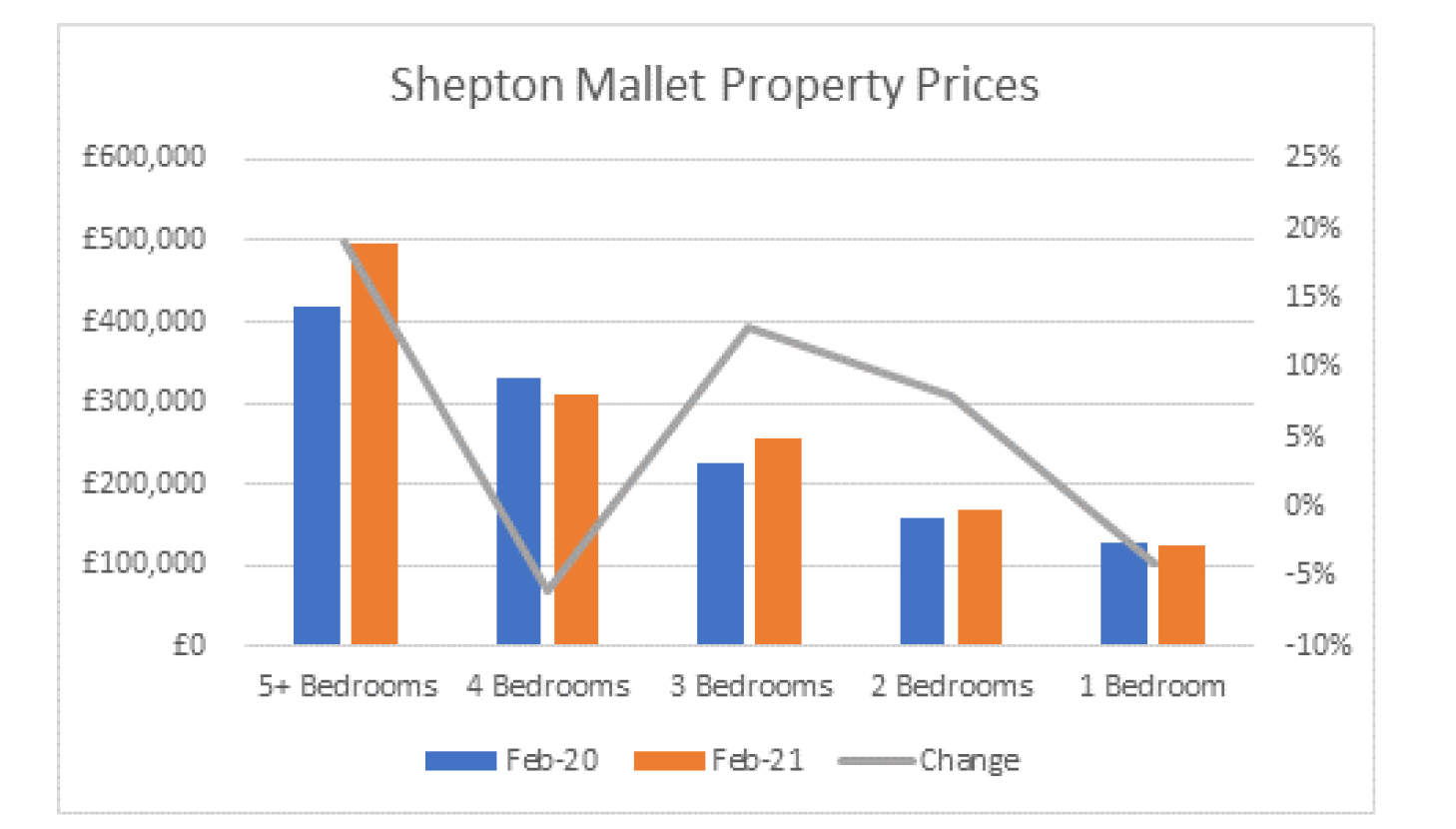 Fig: property prices in Shepton Mallet
Fig: property prices in Shepton Mallet
78 At the beginning of 2012 (the most recent information available) identified the housing mix required for the whole of Mendip is as follows:
 Screenshot 2023 01 11 at 15.05.05
Screenshot 2023 01 11 at 15.05.05
79 It is therefore clear that the provision of smaller units, i.e. 1 / 2 / 3 bedrooms should be favoured in order to provide flexibility to accommodate the widest range of needs.
POLICY FIVE: BUILT UP AREA BOUNDARY
OBJECTIVE 6
To concentrate development within, or immediately adjacent to, existing settlement boundaries
i. The fundamental principle is that the Neighbourhood Plan allocates sufficient land to deliver at least the minimum housing requirement in the Mendip Local Plan and that without a built-up area boundary, significant further development would encroach into the open countryside. The Built-up area boundary is shown in fig below.
ii. Development of Shepton Mallet Parish shall be focused within the Built-up Area Boundary and will generally be permitted subject to meeting other policies in the Plan
iii. Mendip Brownfield register [1] currently identifies 3 brownfield sites within the Built-up Area Boundary:
- SHEP103 Shepton Mallet Prison (has full planning permission)
- SHEP114 Service yard off Church Lane and Peter Street (has full planning permission)
- SHEP115 14/16 Commercial Road, Shepton Mallet (no permission at present)
iv. Development on these sites, and any other brownfield site will be supported subject to meeting other Policies in this plan.
v. This policy proposes that a change is made to the built-up area boundary to enclose the area of land shown on the proposals map below and allocated for housing under Policy 2 of the plan
Reasoned Justification for Policy Five
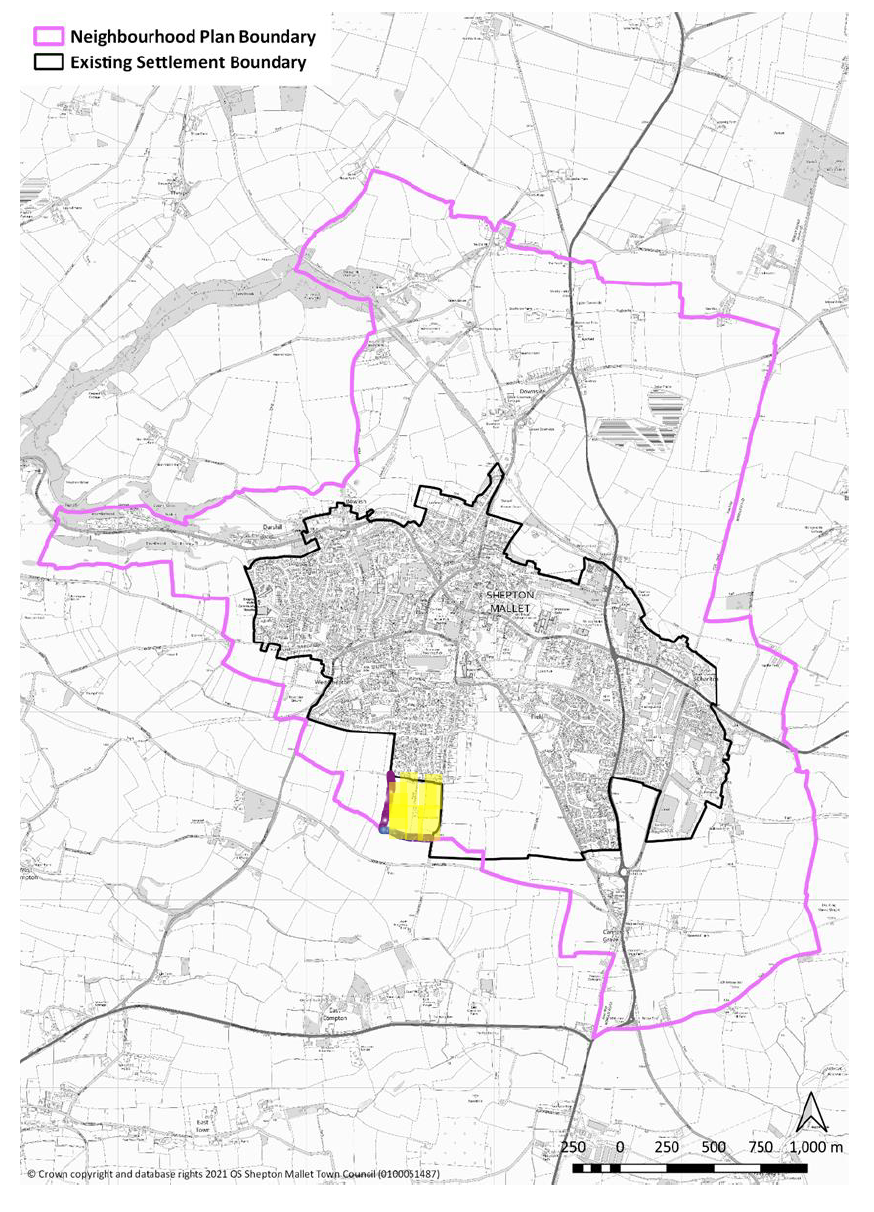 Fig: Existing settlement boundary highlighted area, proposed extension to existing settlement boundary882
Fig: Existing settlement boundary highlighted area, proposed extension to existing settlement boundary882
80 It is expected that the bulk of development will be focused within the built-up area of Shepton Mallet. The town needs to accommodate a degree of growth in order to prosper. However, this must be balanced against the need to preserve its role as a largely rural market town which does not encroach unduly on the open countryside that surrounds it.
81 Policy 2 allocates a site for development which currently falls outside the built-up area boundary. This will require a minor change of the boundary to include this parcel of land of xxx ha’s as shown on the proposals map xxx below:
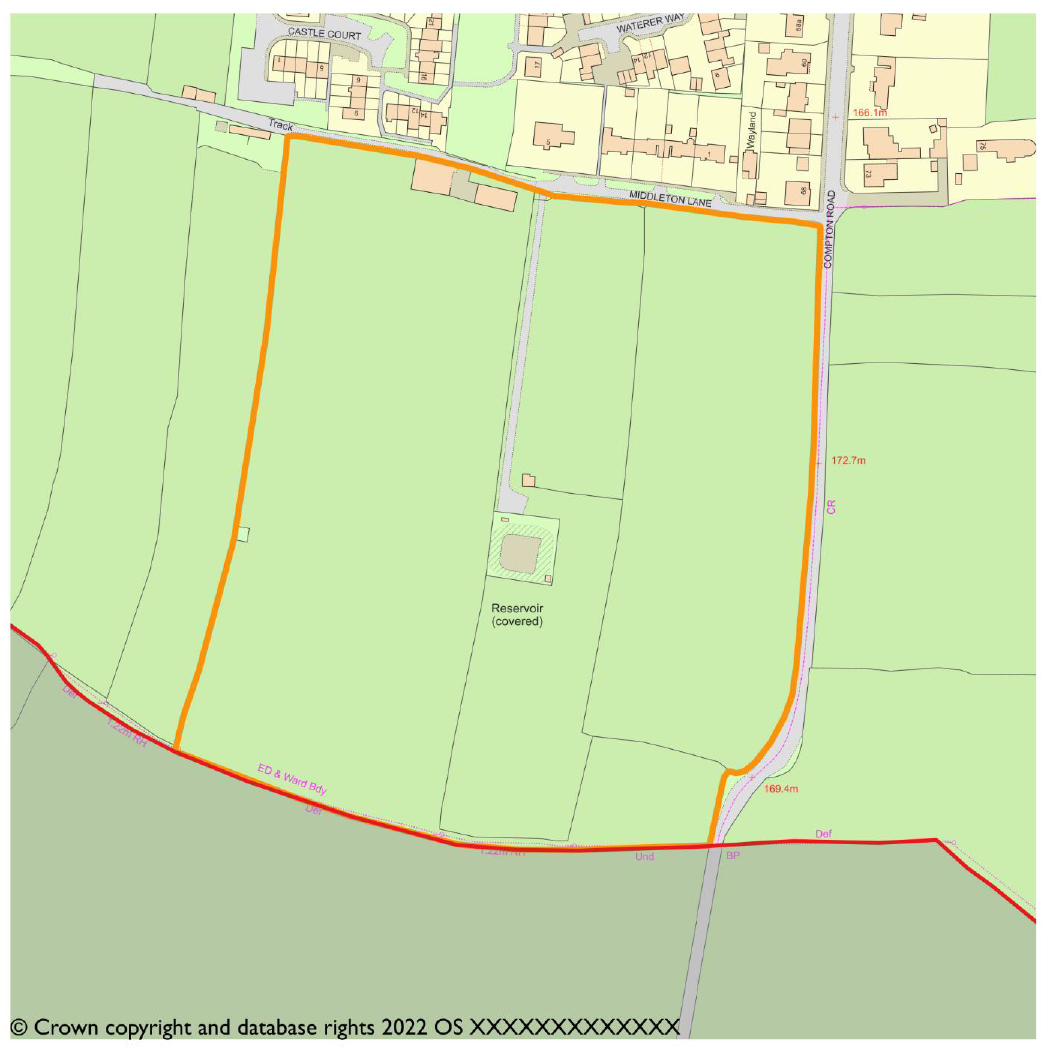
82 Shepton Mallet Neighbourhood Plan Area is close to four European sites under consideration. These are:
• Mells Valley SAC;
• Mendip Woodlands SAC;
• North Somerset and Mendip Bats SAC; and ,
• Somerset Levels and Moors SPA and Ramsar site.
83 Although development outside the settlement boundary would not be within any of these designated areas, it would, however, potentially have a significant impact on whichever lies closest to the development.
84 Given the unique and sensitive nature of much of the land outside the settlement boundaries fi(defined in Figures xxx) the community supports building as many houses as possible within the existing settlement.
85 The site selected in Policy 2, whilst outside the settlement boundary, is adjacent to the strategic allocation of Cannards Grave (Planning Application: 2020/2314/VRC). This means the infrastructure being put in place to service the needs of the new community together with traffic infrastructure, will service the needs of the new community as well. Therefore, no additional infrastructure will be required.
86 Given the current strategic allocation identified for Shepton Mallet, together with the Site Allocation in Policy 2, the housing target plus a 25% buffer can be delivered with no further allocations outside of the settlement boundary.
POLICY 6. DEVELOPMENT IN THE CONSERVATION AREA
OBJECTIVE 7
To maintain the conservation area
OBJECTIVE 21
To have a thriving community which maintains its heritage assets
- The Design and Access Statement and accompanying drawings for all development within, or affecting the setting of the Conservation Area shown on the proposals map must provide sufficient detail for proposals to be properly understood and include:
- Drawings showing the proposals in relation to their surroundings which will include a street elevation and sections across the street.
- For larger developments, including all proposals for new or replacement dwellings three-dimensional drawings from at least two viewpoints will be required.
- Rendered elevations, clearly indicating the proposed palette of materials.
- Details of how window openings relate to the elevation (ie are they flush or set back etc?).
- This Plan includes an Appendix Shepton Mallet Neighbourhood Plan Design Guide which should be used for guidance in conjunction with Policy Six
- Proposals which would cause substantial harm to the heritage assets will not be permitted unless it can be demonstrated that the substantial public benefits gained would outweigh the loss of, or harm to the heritage assets. Proposals which would cause less than substantial harm to the significance of the heritage assets will be considered against the public benefits of the proposed development.
Reasoned Justification for Policy Six
87 Shepton Mallet’s rich history is set out on page of this Neighbourhood Plan. The quality of its heritage assets are recognised through important designations, with a considerable number of Listed Buildings scattered around the neighbourhood area. These are concentrated in particular around the historic town centre. This area is also designated a Conservation Area owing to the dominance of heritage assets in the area. The most prominent heritage assets in the historic centre are The Market Cross, HM Prison and the former Anglo Bavarian Brewery.
88 Elsewhere in the neighbourhood area, there are sporadic properties and developments, a high proportion of which are designated heritage assets. Many of these properties are historic farmhouses and associated agricultural buildings dating to Shepton Mallet’s agricultural heritage.
89 This Policy seeks to ensure that new development in the neighbourhood area conserves its heritage and character, through making a positive contribution to the rural and built character of Shepton Mallet. This policy is supported with detailed guidance contained within the Shepton Mallet Neighbourhood Plan Design Guide.
POLICY SEVEN: PARKING IN RESIDENTIAL DEVELOPMENT
OBJECTIVE 9
To provide appropriate levels of parking within new developments to ensure on road parking is minimised
For all new residential developments, the following minimum standards shall apply for the provision of off-road parking:
- 1-bed house/flat 1 off-road car parking space
- 2-bed house/flat 2 off-road car parking spaces
- 3-bed house/flat 2 off-road car parking spaces
- 4-bed house/flat 3 off-road car parking spaces
- 5+ bed house/flat 4 off-road car parking spaces
Reasoned Justification for Policy Seven
90 It is a major concern of the community that all new dwellings should have sufficient off-road parking spaces to cater for the residents of those dwellings. This is based on experience of recent developments in Shepton Mallet where insufficient parking has resulted in many residents parking on the streets which hinders pedestrian access as well as access for emergency vehicles
91 Somerset County Council has produced Parking Standards which require applicants to use a matrix to calculate the required number of parking spaces for each residential development
92 The Neighbourhood Plan builds on this matrix by making it clear in Policy Seven what is required within each new development
93 Policy Seven requires a high proportion of new houses to be 2 / 3 bedroomed which statistically means a car ownership of 2 cars plus visitor parking.
94 This density of dwelling numbers on the allocated sites as well as any future development is such that this is considered to be reasonable with well-designed proposals.
95 At present, there is parking on blind corners, between parking bollards and haphazardly blocking vehicles. Evidenced by the photographs below.
96 This problem extends to all housing estates in Shepton Mallet and Tadley Acres Residents Association are so concerned at the problems caused by the lack of residential parking that it has prioritised this as a major area of concern and have embarked on a community consultation to seek solutions.
97 A recent fire behind Thorne Lane on the Tadley Acres Estate was inaccessible to the fire service because of parking congestion
98 It is therefore considered vital that adequate parking is provided on all new developments which reduces the need for on road parking except in exceptional circumstances.
